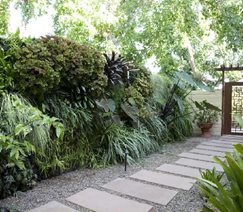Side Yard Design Ideas
Expert tips and ideas for side yard plants, uses, and more
Side yards are often unused spaces that house a home's a/c unit and trash cans. The lack of space and odd dimensions make side yards a challenge. Many homeowners simply avoid them or try to hide it with fencing or planted screens. However, there are a number of ways to maximize your outdoor space by putting your side yard to good use.
Possible uses for a side yard:
- Transition zone that connects the front and backyard
- Vegetable garden with raised beds
- Potting area with built-in storage
- Dog run
- A bocce ball court or horseshoe pits
Time / 01:50
See how this concrete walkway design is adjacent to raised garden beds and a bocce ball court in a side yard.
Selecting Plants for Side YardsIn a side yard, getting the plants right is crucial. You must find a balance between overwhelming the limited space with color and texture and having no plants at all.
Side yard plant tips:
- They must fit the area, plants should be in proportion to the house and available space
- Stick with a limited palette of one or two colors - focus more on texture
- Think vertical - tall, narrow trees and shrubs allow you to get more plants into a small space
Side Yard Ideas & Shade Plants
Time / 01:19
See how this long and narrow side yard was improved with several concrete retaining walls and shade plants.
What the Experts SuggestShawn Boyd, who studied landscape architecture at Pennsylvania State University, says that, "Some side yards can be either highly shaded or exposed to the sun which changes the plant palette and experience through the space. Again depending on the site, a side yard should generally have a path, plants and lighting since people are going to walk through these types of spaces. It should be simple and connect to the overall site."
Brad DeVries, a junior design technician at John K. Szczepaniak Landscape Architect, suggests "creating a series of views, rather than just one focal point at the end of a side yard (i.e. a gate)." This is especially effective in making the space feel less narrow; side yards can easily have a bowling alley effect if not properly executed. Learn more about using multiple focal points in small yards in this article: Maximizing Small Yard Landscapes.
Navid Mostatabi, founder of Mostatabi & Associates a landscape architecture & green consulting firm, suggests that side yards be low maintenance and permeable. "All too often, I find 100% paved side yards with deck drains that outlet through a curb cut at the street. In Southern California our street drains lead directly to rivers and the ocean," he says. 3/8 inch pea gravel or plants with mulch are better options for reducing runoff and pollution.
Shirley Bovshow, a Los Angeles landscape designer, says "side yards are the most under exploited areas in the landscape". Recently, she transformed a narrow side yard to include a path, a sitting area, garden art, a wall fountain and even some fruit trees. Check out the amazing renovation (pictured) at her blog: EdenMakersblog.com. When selecting trees for narrow areas, Shirley suggests that the trunks have a narrow profile and that the lowest limbs are higher than 7 feet so that the average size person can walk underneath.







